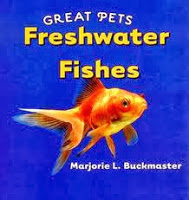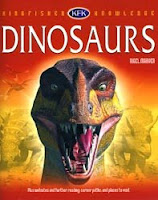Great Pets
by Marjorie L. Buckmaster
I\’m planning on starting up an old hobby- keeping tropical fish. It\’s been sixteen years or more since I had a fish tank, so while I wait for the setup to be complete and the tank cycled, I\’m reading up on all I can find and doing my research about what kinds of fish I\’ll get. This starts, of course, with lots of online reading. I\’ve read posts on fish forums until I feel like my eyes are going to fall out. So on our latest trip to the public library I brought home all the books I could find that seemed applicable- either to tropical fishkeeping in general, or to the specific species I\’m considering for my tank. The selection among the adult non-fiction books is pretty slim, so I brought home a stack from the juvenile section as well. If nothing else, these books remind me of the basics in a very solid way, and they usually have fantastic photographs to admire while I daydream about my own aquatic pets.
So, Freshwater Fishes was the first one I read. My older daughter immediately commented on the title: isn\’t the plural of fish just fish? The book explains: when you speak of two or more fish of the same species, you use the plural form fish. If you\’re talking about a group of different species together, you say fishes. I had no idea!
That\’s not the only thing this book taught me. I knew that goldfish have been kept domestically for centuries, and that the practice began in China, but I didn\’t know that people have been keeping fish for over 4,500 years, and that they were first kept as food stock. I also learned a bit about the presence of fish in mythology, some cultures even have fish deities- although the book only touched on this.
Mostly, this book was a reminder of the basics for me again. It explains the anatomy of fishes, their dietary and temperature requirements, how to set up a fishtank, how to clean it, how to choose healthy-looking fish and steps to introduce them into the aquarium. There are also some brief descriptions of popular species including: bettas, mollies, goldfish and koi, guppies, tetras, gouramis and algae eaters. The book tells young readers how to keep their fish healthy with regular water changes, strict feeding schedules and being careful to match fish temperaments when keeping a community tank, as well as being mindful of how large the fish will grow, so they have enough space.
I was a bit surprised that with all the details on regulating temperature and such, one important part was left out: dechlorinating or conditioning tap water before adding it to the tank. I shouldn\’t be too critical: the book is probably meant to give kids facts and get them excited about keeping an aquarium, expecting that most will have an adult helping. But still, it\’s such an important thing to omit! Another thing that alarmed me was that the book says you can keep goldfish in a bowl with only once-a-week water changes. That\’s bad advice. I started out with goldfish in a bowl myself as a kid, and I remember very clearly that I had to change the water once a day. Goldfish simply poop a lot. It wasn\’t until I put my goldfish in a filtered tank that I had ones survive any length of time- I think my oldest lived to be a few years. (I did have a certain pair of angelfish live for ten years, when later I had tropical fish).
Well, I liked the book for all that it reminded me of, and enjoyed the pictures. I\’m getting excited about my new venture!
Rating: 3/5 48 pages, 2008












